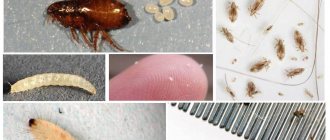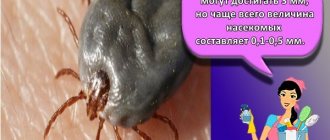Ticks and fleas not only cause discomfort for dogs, but also carry dangerous diseases. Fleas are the cause of dermatitis, which causes various complications, including otitis media if the dog actively scratches its ears. Ticks are carriers of Lyme disease, encephalitis, babesiosis, and other pathologies. Today we will talk about how to protect your dog from ticks in spring and other times of the year.
How to protect your dog from fleas and ticks: basic methods
The dog must be regularly treated with flea and tick medications, even if there are no parasites. Timely prevention will protect your pet from pests and prevent them from gaining a foothold on the dog’s fur and skin when they attack the dog.
Most modern remedies cause paralysis and rapid death of the parasite. Their effectiveness and duration of protection directly depends not only on the brand, but also on the product you use to treat your dog.
Collars
Collars give a good long-lasting effect, are inexpensive, and easy to use. It is enough to put the collar on the dog and not remove it for 1-2 months. They protect dogs well, who live in the yard, near the forest, and often walk in the fields.
The downside is that the collar often causes allergies. It manifests itself in the form of itching, redness of the skin, so the symptoms are easily confused with a reaction to parasites. If your dog is itching while wearing a flea collar, but there are no parasites, change the product.
Pills
Tablets are the answer to the question of how to protect a dog from ticks in the country. They cope with the task better than other means. They have a systemic effect and are effective for 1 to 3 months. When the bloodsucker begins to suck blood, the active substance enters his body, causing instant paralysis and rapid death. Therefore, even if a tick or flea bites an animal, it will not be able to cause harm.
There is a lot of controversy about the effect of tablets on a dog’s health. If you decide to use tablets to protect your dog, buy only proven products that are safe for your pet.
Drops on the withers, sprays
Drops on the withers, sprays - topical preparations. Their active substance is distributed not through the bloodstream, but through subcutaneous fat. The drug does not enter the plasma. It causes parasites to become paralyzed at the first contact with the poison, and after a while they die. Drops give a short-term effect. They protect against ticks for 2-3 weeks, and against fleas - a little longer.
In order for the anti-tick product for dogs to work, the pet must not be washed 3 days before and after treatment. If the dog gets caught in the rain after applying the product, there is a high probability that the drug will be washed off. Tick protection for dogs should be applied not to the fur, but to the skin so that the dog does not lick it off - near the ears, shoulder blades.
Plus, drops and sprays against ticks rarely cause allergies. If it appears, to remove the symptoms, just wash off the product.
Shampoos
The effectiveness of shampoos is lower than that of drops; the duration of action is from 1 to 3 days. They are recommended to be used not so much for prevention as for treating the animal. According to the instructions, you first need to bathe your pet to kill the parasites, then after a few days use anti-tick drops for dogs. They not only get rid of pests, but also quickly relieve itching and inflammation, and heal the skin.
Shampoo can also be used a few days after treating the animal with drops. It will wash away dead fleas and other parasites.
How to remove fleas from a dog using folk remedies at home
Dog parasites cannot tolerate strong odors. Therefore, the most effective way to remove them is with essential oils.
In pharmacies you should pay attention to:
- Treat the wool with water with the addition of essential oil. For convenience, use a spray bottle. Pay special attention that the mixture should not get on the animal's face.
- Spray your pet's bedding with any of the above oils, diluted in a ratio of 20 drops per glass of water.
- Also disinfect the places where the dog likes to rest: sofas, armchairs, carpets.
- Add essential oil to shampoo and wash your pet at least once a week.
- Apply an undiluted drop to the animal’s withers.
How to protect your dog from fleas
A flea can jump on a dog even if the pet has not been in contact with other dogs. Therefore, prevention cannot be ignored. If a dog is infected, it is necessary to treat not only the dog, but the entire apartment. Particular attention should be paid to the bedding on which the dog sleeps.
The Best Flea Treatments for Dogs
The best protection against fleas for dogs is provided by tablets that cause paralysis in fleas. The rating is topped by the following flea remedies for dogs:
- Bravecto (fluralaner) – kills fleas in 8 hours. Validity period: 3 months.
- Nesgard (afoxolaner) – parasites die after 6 hours. Give to your pet once a month during the active season.
- Simparica (sarolaner) – kills fleas in 8 hours. Give once every 32 months.
If you are concerned about the safety of the tablets, buy drops. Effective flea treatments for dogs:
- Frontline COMBO (fipronil, S-methoprene) is a drug that protects against fleas for 90 days.
- Beafar (diazinon) – protects against parasites for 3 weeks.
- Advantix (imidacloprid and pyrmethrin) – keeps fleas away from your dog for a month.
Among the cheap drugs, we can highlight Bars, which protects the dog for 1-2 months. Don't be afraid to buy an inexpensive flea treatment for dogs. The fact is that fleas develop resistance to many insecticides, regardless of their price. Therefore, even expensive drugs become ineffective over time.
Many people do not trust cheap flea drops for dogs, and this is their advantage. Insects encounter them little, so they quickly die without having time to develop resistance.
Important: if you notice that the flea drug has ceased to have the desired effect, buy another flea drug for your dog.
Preventive measures
Daily prevention is the best protection against fleas. Many breeders believe that the pet does not have parasites, but more often than not this is not the case. There are many ways of infection, so regular prevention will only be beneficial. Basic measures:
- Maintaining cleanliness in the house, enclosure or booth.
- Constant inspection of the body for larvae and fleas.
- Keep your puppy away from homeless animals.
- Constantly use antiparasitic agents.
- Perform routine vaccinations.
The whole difficulty of getting rid of fleas lies in the fact that 80% of pharmaceutical drugs can only be used from six months of age. Only a small proportion of funds can be used from the first or second month. The safest measures are to use flea shampoo based on natural substances. For puppies up to a month old, folk remedies are chosen (tar soap, wormwood infusion, homemade shampoos).
If you notice symptoms and suspect that your dog has fleas, then the question of how to remove them at home should be resolved quickly. The blood-sucking parasite is prolific and not at all harmless. It is easier to fight it at the very beginning of infection. At this stage, folk remedies for fleas will help. To choose an effective drug on your own, sometimes you have to try several products, and this is an extra expense. We will tell you what to do and how to treat your pet.
How to protect your dog from ticks
Ticks are more dangerous than fleas because they can crawl from dogs to human skin. Research shows that 6 out of 100 ticks are infected with viral encephalitis alone; in some areas the percentage is higher. Therefore, when treating your dog, you protect not only the pet, but also yourself.
The Best Tick Remedies for Dogs
To protect a dog from ticks, the same products are used as against fleas, only they act on arthropods for 1-2 weeks less.
The best and most effective tick repellents for dogs are Bravecto, Nesgard and Simparica tablets. Don’t think that if you give your dog a pill and go into the forest, you won’t find a tick on your pet. If a parasite falls on a dog, it will crawl along it until it burrows into the skin. The tick will become poisoned when it starts feeding. He will be instantly paralyzed and will die after some time.
Therefore, if you gave your dog a pill, went into the forest and found a tick crawling on your pet, don’t panic. Carefully remove the parasite and destroy it.
Frontline and Advantix also protect well against ticks. These tick repellents for dogs top many ratings. You can also use shampoos (Pchelodar, Bea Flea), which will help if you did not notice a tick during the inspection. We should not forget that the shampoo does not last long and gives a good effect as a comprehensive protection.
The use of folk remedies
An alternative to drugs are folk remedies. They are safe and effective.
- Herbs. Hellebore, eucalyptus, tansy and wormwood repel fleas. Decoctions and infusions are prepared based on these plants. They bathe your pet in them.
- Laundry soap. Treatment is carried out using a special solution. First, a decoction of eucalyptus is prepared. A few drops of fir oil are added to it. Then grated laundry soap is added to the composition. The resulting solution is used to wash the pet.
- Garlic. Parasites cannot tolerate this smell, so this folk remedy is effective in the fight against fleas. To prepare it, you need to chop three cloves of garlic and pour a glass of water over them. The resulting mixture is infused overnight. The solution is applied to those areas of the body where the pet cannot lick itself.
- Onion. It works on the same principle as garlic. Finely chop the onion and add water (1 cup). Laundry or tar soap is added to the solution. The solution is thoroughly mixed. The resulting product is used to treat the pet.
- Apple vinegar. The solution is prepared using vinegar and water. These components are mixed in a ratio of 1:3. The product is applied to the dog's fur and left for an hour. After the specified time, the solution is washed off and the wool is combed.
- Essential oils. Parasites cannot tolerate strong odors. The maximum effect is provided by esters of tea tree, coniferous trees, eucalyptus and citrus fruits. They can be added to bathing water or applied to your pet's fur.
How to remove a tick
If you find a tick attached to your dog, do not pull it out under any circumstances. To remove it:
- Take tweezers and grab the tick as close to the skin as possible.
- Gently pull out the tick by turning it clockwise or counterclockwise.
- Do not pull sharply upward or loosen the tick, otherwise you will tear off its head, which will remain in the body. He may also get scared and inject dangerous saliva into the blood.
To make removing a tick easier, buy a special device in the store in advance and follow the instructions.
Prevention measures
Helpful Tips:
What signs indicate fleas in a dog and what is the most effective prevention? Which products are more suitable: drops on the withers, spray, shampoo, collar or essential oils? Do folk remedies help: wormwood, garlic, celandine, vinegar or tar soap. Let's take a closer look.
Sooner or later, all pets become infected with fleas. There is nothing catastrophic about this if the situation is brought under control in time. Common signs that are accepted are itching and discomfort. However, itching can be a symptom of a skin disease or other ailment, so you should not make hasty conclusions.
How to protect your puppy from ticks
Most flea and tick treatments are made for puppies 8 weeks and older. Until this time, it is necessary to protect its contact with the environment. It is important to remember that he should not be allowed outside until the vaccination is completed. The first vaccination is given at 2 months, the second after 10 days.
Therefore, when the doctor allows the puppy to go outside, it can already be treated with drops against fleas and ticks. Manufacturers of Bravecto, Nesgard, Simparica claim that the tablets can be given for 8 weeks. But it is important to remember that a young, growing organism can react negatively to any chemical, so drops against ticks are preferable.
If you pick up a puppy with fleas and ticks from the street, wash it with shampoo several times at short intervals. For example, Doctor Zoo can be used from 2 weeks. It has a mild effect, and the risk of infection is higher than the risk of getting a negative reaction from the drug. If Doctor Zoo is not in the pharmacy, ask your veterinarian to sell a product that can be used to treat babies against fleas and ticks.
How to treat a dog?
- One method is washing the dog using tar soap
.
This soap is an excellent alternative to industrial shampoos. However, do not overdo it: the soap dries out the delicate dog skin.
Especially if it's leather. - A tincture of wormwood is rubbed
into the surface of the dog’s body and the floor is treated with a decoction of the plant. - A bed made of pine sawdust is arranged in the pet's kennel
If there are too many pests, it is worth treating the apartment: wash the floors and spray with special products.
To treat puppies, use only those products that are intended for their age.
Medicines for adult animals can seriously harm babies.
How to protect a pregnant and lactating bitch from parasites
It is highly undesirable to treat a female dog for fleas during pregnancy. The owner must take this into account and be sure to carry out the treatment earlier. If you cannot do without it after pregnancy, consult your doctor. He will tell you which flea and tick treatment is best for your dog.
Manufacturers of Bravecto, Simparica, Nesgard allow pills to be given during pregnancy. But we must remember that at this time, especially at the beginning of pregnancy, the baby’s organs are formed. Any tablets can affect this process, so it is better to use drops against fleas and ticks.
As for lactation, flea and tick tablets can get into the milk and cause a negative reaction in puppies. Manufacturers do not indicate this, but many drugs have this effect on infants. Therefore, to protect the bitch, it is better to use anti-tick drops, applied to the withers, between the shoulder blades. It is imperative to ensure that the puppies do not lick the flea and tick medication when the bitch is lying down.
When can a puppy be treated for fleas?
There is a large selection of drugs and methods to combat parasites. But it is worth noting that for very small puppies (up to 1 month) none of the chemicals are suitable, since the baby’s immunity is still developing. Here you can only help mechanically. For this:
- The puppy is thoroughly washed in a decoction of herbs (wormwood, lavender) or with essential oils added to the water (cedar, pine needles, citrus). It is safe to use tar soap. Water should not get into the nose, ears, eyes;
- the dog is dried, laid out over a white cloth and the fur is carefully combed out with a thick comb;
- In parallel with this, the dogs’ habitat is treated – the bed and toys are cleaned using special means.
How to protect an older dog from fleas and ticks?
An older dog should definitely be treated for fleas and ticks. As they age, their immunity declines and they become vulnerable to diseases that they could previously easily cope with. They often develop dermatitis from fleas. Constant scratching can cause inflammation of the lymph node in the ear, which may require surgery. Old animals do not tolerate anesthesia well and take a long time to recover.
Older dogs also become more vulnerable to diseases transmitted by ticks. They have a harder time coping with encephalitis, Lyme disease and other dangerous pathologies than younger dogs.
As in other cases, drops, sprays, shampoos, and tablets can be used to protect the dog. When choosing a product to protect dogs from fleas and ticks, consider the following parameters:
- Health. If the dog is sick or has a weak immune system, it is better to give drops.
- Allergy. With age, allergic reactions often occur. If your dog rarely goes to the forest or fields, it is better to limit yourself to flea and tick drops. If a reaction occurs to them, just wash the dog. If an allergy manifests itself to an anti-mite tablet, serious consequences are possible.
- Age. The older the dog, the more gentle the flea and tick treatment should be.
Before treating your dog for fleas and ticks, consult your doctor. He will examine your pet, prescribe tests if necessary, and recommend the best tick repellents for dogs.
Where does a puppy get fleas?
In fact, if you have a “domestic” dog that lives primarily indoors, where can parasites come from? Unfortunately, flea infestation is much easier than we would like.
- From another animal.
- While walking. By the way, a tick can get in here. If some breeds (Spitz) can do without walks, then the popular shepherd dogs, Labradors or huskies cannot.
- Cubs can get fleas from their mother. Infection occurs in the form of transmission of larvae, which at first do not show themselves in any way and are difficult to detect. It is even more difficult to get rid of them on a newborn dog.
- In premises where there are many animals or where other pets live, but no sanitary measures are taken.
You can determine that your pet is attacked by parasites by the fact that he begins to scratch and snort a lot. In addition, insects can be noticed visually if you often pick it up. Flea treatment should be done immediately, without delay.
Folk remedy for ticks and fleas for dogs
Previously, in order to rid dogs of fleas and ticks, pets were washed with gasoline, vinegar, alcohol, and other solutions. Then they spent a long and tedious time catching parasites in the fur. Don't do this. These home remedies for fleas help your dog temporarily. They can only temporarily stun the flea, when it comes to its senses and resumes its activities.
If you stubbornly avoid "chemicals", you can try essential oils. You can also prepare solutions from them and spray your dog and apartment. Fleas are repelled by orange and wormwood. Ticks are repelled by cedar, lilac, bird cherry, eucalyptus, and lavender. These plants briefly stun fleas and ticks and may repel them, but they do not provide much effect.
Now there are many expensive and inexpensive products on sale that effectively get rid of parasites. The main thing is to buy a tick repellent for dogs at a veterinary pharmacy. Avoid bazaars where they might sell you counterfeits. The insects die quickly after applying insecticides, and you don't have to spend much effort to remove them from your dog. It is enough to bathe your pet with a special shampoo a few days after treatment.
How to get rid of parasites in a one-month-old puppy
If a baby who is only 1 month old has fleas and they bite very hard, then it is necessary to get rid of the parasites at home radically, but at the same time, carefully.
Prepare a strong decoction from a mixture of tansy and wormwood (you can also take mint, calamus or wild rosemary). Immerse your baby in it, but make sure that the broth does not get into his eyes, nose and ears. Keep the puppy in this bath for 15 minutes. Then dry and thoroughly comb out the parasites over a white piece of cloth.
You can also poison blood-sucking insects from a month-old baby with tar soap. Wet the puppy thoroughly, then soap it generously. Then wrap it in film and wrap it in a towel or wool blanket. After 20 minutes, thoroughly rinse off the foam containing the killed pests from the puppy, dry and comb out flea eggs and larvae from the fur.
What to do if your dog has fleas
Having discovered parasites in a dog, you need to act immediately to avoid their massive spread.
- Choose a suitable anti-flea product, following the advice of a veterinarian.
- You need to fight fleas strictly according to the instructions for the drug. And if repeated treatment is prescribed there, you should not neglect it - this can lead to a massive proliferation of parasites.
- Treat the apartment followed by wet cleaning.
- As a preventative measure, you should limit your pet’s contact with stray animals.
Accurate and timely implementation of these tips will help cure your pet of annoying parasites and prevent their occurrence. If there is a strong accumulation of fleas in a house or apartment, it is recommended to use the service of a company that will carry out pest control at a professional level.
Causes and signs of infection
The first and main sign that your pet has fleas is its constant scratching. He can also chew his fur. And it is possible to find out whether the puppy was really attacked by parasites only through a detailed examination. You can comb against the grain to check for the presence or absence of bloodsuckers. They usually like to be located behind the ears, as this area has thinner skin and is easier to bite.
Flea saliva causes very strong allergic reactions in babies, so redness will be another symptom. Sometimes it happens that due to the negative effects of parasites, hair loss may occur. Therefore, it is worth closely monitoring changes in the dog’s behavior and appearance.
Some argue that a dog that lives in an apartment and occasionally goes outside cannot become a carrier of fleas. However, this opinion is not correct. Bloodsuckers parasitize not only yard dogs, but can also feel comfortable on humans. In this case, it is he who is the carrier and is able to bring fleas into the house, on clothes or shoes. Having discovered a source of food, bloodsuckers settle and multiply fruitfully in the dog’s fur.
When piercing the skin, the flea injects saliva into the wound, which causes:
- Severe itching, accompanied by redness and swelling;
- Skin and viral diseases;
- Hair loss;
- Allergic reactions;
- Anemia in puppies, which can result in death.
How can you tell if your dog has fleas? It’s not difficult to verify their presence; the main thing is to take a close look at the animal’s behavior.
- If your pet is concerned about frequent itching of different parts of the body.
- Flea bites on the dog are visible in the form of wounds and redness.
- The animal's fur is strewn with white grains resembling salt (this is what flea eggs look like), small black inclusions (larvae) and the remains of insects (excrement). Fleas on dogs
- You can detect fleas on a dog while bathing, when the parasites panic and they jump into the water en masse or cluster around the head.
- The presence of bloodsuckers can be determined by visual contact or by combing with a thick comb (the parasites remain between the teeth).
Basic rules for treating a puppy for worms
Deworming should be carried out taking into account the following precautions:
- carefully follow the dosage, method, frequency of treatments specified in the instructions;
- Buy a product taking into account the age of the pet. Do not treat pups with adult formulations.
The first treatment should be carried out on the baby at 2-3 weeks, provided that he has reached a weight of 500 g. Then repeat the procedures with an interval of 14 days between them. In the future, prevent infestations in accordance with the manufacturer’s recommendations. Typically, fleas are treated quarterly, and worms are treated monthly until 6 months of age.
Yuri Lizvinsky Veterinarian, head of the training department of Apicenna LLC











